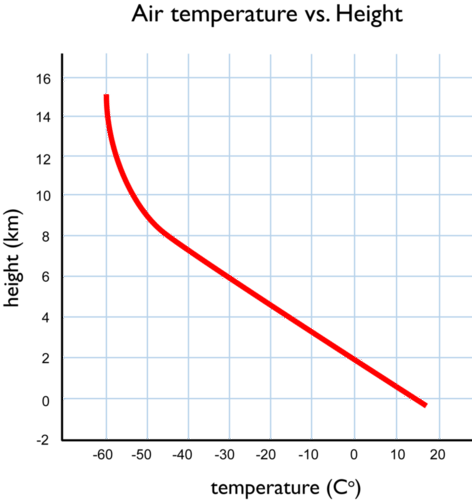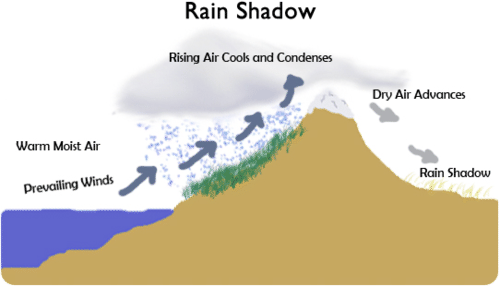12.5: Effect of Altitude and Mountains on Climate
- Page ID
- 5532
How much does the climate vary across Washington State?
The first photo is of Olympic National Park by the Pacific Ocean. The area is wet; very, very wet. Moving eastward, you find Mt. Baker, one of the Cascades volcanoes. The climate on the mountain is very different from the climate near the ocean. It is extremely cold with abundant snowfall in winter. The third photo is of eastern Washington. Much of the land is farmed. The climate is much drier for two reasons. Can you determine what they are?
Mountains and Climate
Did you ever hike or drive up a mountain? Did you notice that it was cooler near the top? Climate is not just different on a mountain. Just having a mountain range nearby can affect the climate.
Altitude and Temperature
Air temperature falls at higher altitudes (Figure below). Why does this happen? Since air is less dense at higher altitudes, its molecules are spread farther apart than they are at sea level. These molecules have fewer collisions, so they produce less heat.
Air temperature drops as you go higher.
Look at the mountain pictured below (Figure below). The peak of Mount Kilimanjaro, Tanzania (Africa, 3° south latitude) is 6 kilometers (4 miles) above sea level. At 3°S, it’s very close to the Equator. At the bottom of the mountain, the temperature is high year round. How can you tell that it’s much cooler at the top?
Mount Kilimanjaro has very different climates at the top and bottom.
Mountains and Precipitation
Mountains can also affect precipitation. Mountains and mountain ranges can cast a rain shadow. As winds rise up the windward side of a mountain range, the air cools and precipitation falls. On the other side of the range, the leeward side, the air is dry, and it sinks. So there is very little precipitation on the leeward side of a mountain range. The figure below shows how this happens (Figure below).
What role do prevailing winds play in a rain shadow?
Summary
- Where air is denser, the air temperature is higher.
- Rainshadow effect occurs on the leeward side of a mountain range.
- Maritime air may become stuck on the windward side of a mountain range. For this reason it is unable to bring cooler air farther inland.
Review
- Why does an increase in altitude cause a change in temperature?
- What is rain shadow effect?
- What are the two ways that a mountain range can affect climate?
Explore More
Use the resource below to answer the questions that follow.
- What does wind do as it goes up and over a mountain range?
- What is the climate on the windward side of a mountain range like?
- What is the climate on the leeward side of a mountain like?
- What are rain shadow deserts?
- What are the characteristics (wind, precipitation, vegetation) seen on the windward side of the Sierra Nevada Mountains?
- What are the characteristics (wind, precipitation, vegetation) seen on the leeward side of the Sierra Nevada Mountains?





